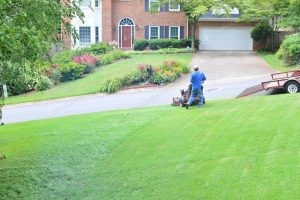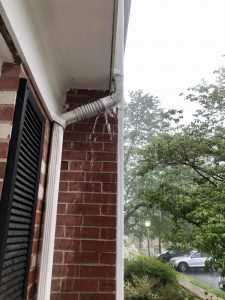As the literal building blocks for the rest of your home, your foundation works hard to support the rest of your home while providing a barrier from the moisture, insulation from the cold, and protection from the shifting soil that surrounds it. Your home’s foundation is one of the most important components of your house, and yet few homeowners give it much thought. One of the easiest ways to care for your home’s foundation is to be mindful about the landscaping that surrounds it. Read on to discover our best landscaping tips that will help protect your home’s foundation and ensure it stands the test of time.
Be careful planting large trees around your property.
 Trees typically have root growth underground that is as large as the branch system aboveground. Be sure to maintain a tree-free barrier of no less than 20 feet on all sides of your home. Trees planted too close to your home can cause two significant problems for your foundation. First, roots reach through crevices in the soil in search of water. While it may seem like these tiny little roots are no match for your foundation walls, remember that roots grow and will push the foundation walls out of the way as they do. Second, the root system of a tree is designed to provide nutrients and water to the branch system above the ground. These roots leach significant moisture from the soil, which can cause the soil around your foundation walls to dry out and shift away from the walls. This shifting can cause your foundation walls to move, crack, or collapse. Keep water-loving trees (like willows) even further from your home. The roots of these trees will seek out abundant water sources, which often leads them to invade and destroy drainage systems, including foundation drains.
Trees typically have root growth underground that is as large as the branch system aboveground. Be sure to maintain a tree-free barrier of no less than 20 feet on all sides of your home. Trees planted too close to your home can cause two significant problems for your foundation. First, roots reach through crevices in the soil in search of water. While it may seem like these tiny little roots are no match for your foundation walls, remember that roots grow and will push the foundation walls out of the way as they do. Second, the root system of a tree is designed to provide nutrients and water to the branch system above the ground. These roots leach significant moisture from the soil, which can cause the soil around your foundation walls to dry out and shift away from the walls. This shifting can cause your foundation walls to move, crack, or collapse. Keep water-loving trees (like willows) even further from your home. The roots of these trees will seek out abundant water sources, which often leads them to invade and destroy drainage systems, including foundation drains.
Landscape on all sides of your home.
One common mistake homeowners make is landscaping the front of their home while leaving the remaining three sides relatively bare. Not only does this create an imbalanced aesthetic for your home, but it also creates an imbalance of moisture in the soil surrounding your home. Landscaping tends to require more frequent watering, which means the soil underneath remains moist throughout the summer. As moisture levels in the ground wax and wane throughout the summer months, the soil naturally expands and contracts. Landscaping and mulching the ground around your foundation helps maintain more consistent moisture levels year-round. Surrounding your home with landscaping will ensure consistent pressure and even moisture levels on all four walls of your foundation.
Grade soil around your foundation to direct water away from your home.
 Ideally, the soil surrounding your foundation walls will have a 5% slope away from your home, dropping 6 inches in the first ten feet around your home. A proper grading around your foundation will use gravity to keep water from pooling around your foundation walls. An improper slope—one that is flat or, even worse, graded toward the foundation—will allow excess moisture to collect around your foundation walls, which can lead to basement leaks and even foundation collapse. Use these helpful tips for measuring the grade around your foundation to ensure proper drainage around your foundation walls.
Ideally, the soil surrounding your foundation walls will have a 5% slope away from your home, dropping 6 inches in the first ten feet around your home. A proper grading around your foundation will use gravity to keep water from pooling around your foundation walls. An improper slope—one that is flat or, even worse, graded toward the foundation—will allow excess moisture to collect around your foundation walls, which can lead to basement leaks and even foundation collapse. Use these helpful tips for measuring the grade around your foundation to ensure proper drainage around your foundation walls.
Leave the top 2-3 inches of the foundation exposed.
In most homes, the foundation walls extend up past the soil by a few inches to just shy of a foot, depending on the grading around the home. The sill plate sits atop the foundation walls, acting as the base for the home’s framing. When grading the soil, mulching, or landscaping around your foundation walls, you want to be sure to leave 2-3 inches of your foundation exposed for a couple reasons. First, you want to be able to allow your foundation walls to breathe and avoid trapping the moisture from the surrounding soil inside the foundation walls. This also allows you to monitor the foundation, keeping an eye out for shifts or cracks that may extend above the soil. In addition to this, leaving 2-3 inches of foundation wall free from soil or landscaping prevents moisture from being wicked into the home’s wooden framing, which can lead to significant water damage.
Upgrade your gutter systems.
 Your home’s gutters allow an escape route for precipitation coming off your roof. Most people don’t realize that gutters play a key role in keeping the basement dry and foundation walls intact. In order to function properly, gutters need to be kept clean and clear of any debris which may clog the gutters and allow rainwaters to overflow and collect around the foundation. In some cases, you may need to upgrade the gutters themselves to ensure they provide adequate drainage for the size and pitch of your roof. Very often, the gutter systems in older homes need to be upgraded to properly direct water away from the home.
Your home’s gutters allow an escape route for precipitation coming off your roof. Most people don’t realize that gutters play a key role in keeping the basement dry and foundation walls intact. In order to function properly, gutters need to be kept clean and clear of any debris which may clog the gutters and allow rainwaters to overflow and collect around the foundation. In some cases, you may need to upgrade the gutters themselves to ensure they provide adequate drainage for the size and pitch of your roof. Very often, the gutter systems in older homes need to be upgraded to properly direct water away from the home.
Trust Aapex Construction & Restoration with Your Home’s Foundation
Aapex Construction & Restoration is a locally owned and operated company that specializes in insurance and non-insurance restoration projects, both commercial and residential. With more than 20 years of experience in the industry, we pride ourselves on exceeding our clients’ expectations when it comes to quality, attention to detail, and customer service. Our goal is to assist you in every possible way, including acting as your advocate with an insurance company, when needed. Contact us today for a consultation!
Related Articles
The Purpose & Importance of Gutters
Landscaping Tips to Prevent Basement Flooding
Water in Your Basement: Sources & Solutions


Great tip about leaving 2-3 inches of foundation wall free from soil. I need to get a landscaper to help out with the backyard path. I’ll have to make sure that they are licensed to work in the state.